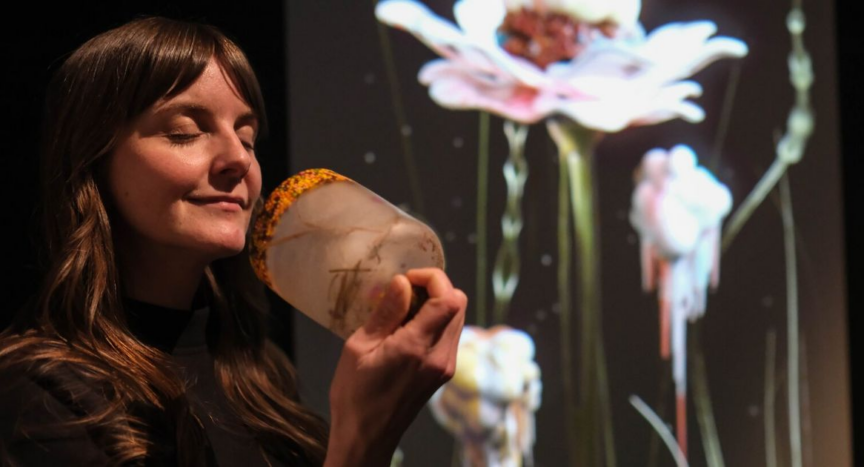Standing inside the dark museum on a recent wintry evening, I picked up a small bell jar, brought it up to my face and gave it a good, deep sniff.
I closed my eyes. Hm. Smells milky and soft. I’m getting whiffs of coconut, fresh linen — maybe dryer sheets. And is that a hint of vanilla?
“Fischersund: Faux Flora,” a multimedia exhibit on view through Jan. 26 at Seattle’s National Nordic Museum, is sensational — literally.
Fischersund, an Icelandic family perfumery and art collective comprising Sigur Rós frontman Jónsi Birgisson and his younger sisters Inga, Lilja and Sigurrós, created this immersive, scented show as a way to awaken our senses, trigger memories and transport us to a different world.
While “Faux Flora” fits into a trend of olfactory exhibits at local and international museums, the show engages all of our senses but one (taste). While gentle soundscapes that trickle and crackle and smack sound overhead, alien, imaginary 3D-sculpted flowers bloom and grow and bubble on dark video screens; resin artworks and large-scale photos hang nearby. Each smell, perfumes made from synthetic and natural oils, is contained in pompoms affixed to the interior of small resin bell jars, which visitors are invited to pick up.
The jar I was sniffing contained a pillowy, innocent smell titled “White porcelain mountain milk flows from watery lips” — a one-line poem referencing Iceland’s mountain creeks.
“They are completely white, and we call them mountain milk,” Inga Birgisson said as she accompanied me on a journey through the dim exhibition space.
While inspired by Icelandic flora, Fischersund also taps into more universal experiences. Organized into five chapters, the exhibit guides visitors through the life stages of humans and plants, a Proustian promenade through birth (germination), childhood (growth) adolescence (flowering), maturity (seed formation) and death (seed dispersal).
“What are the feelings that you connect with birth and this time in your life, when you’re giving birth, or that you are being born?” Inga said as we stood in front of screens where tendrils emerged from milky-white orchids like fountain rivulets, and plant-stamen pacifiers grew larger while a soft soundtrack trickled above us. “And of course, it’s skin and milk and clean linen and all these things.”
Perhaps you don’t remember your own entry into the world — but you probably recall the boundless pleasure of running wild in nature, or the resulting road rash (represented here in a Band-Aid-petaled flower plus a cold, metallic odor)? The candy consolation? (A jelly-marshmallow flower tower and sweet, citric smell.) Or your first kiss? (Two carnivorous flowers leaving a trail of saliva as their lips smack against each other in slow motion, accompanied by a synthetic, lipsticklike aroma.)
The show’s abstract sonic landscapes — calm, galactic sound waves resounding through the space — add an otherworldliness to the experience. Music and perfume are similar, said Jónsi, who created the soundtrack with musicians Kjartan Holm and Sin Fang. Both have low, high and mid notes, and are “just in the air,” Jónsi said. “They kind of both move you in an invisible way, which I think is very powerful.”
But smells are special. While sound, sight and other sensory input goes through the brain’s thalamus, smells take a shortcut directly to the parts of our brain that generate emotion and store and organize memories.
“This could explain why studies have found that, when compared with memories triggered by other senses, odor-evoked memories tend to be more emotional and more likely to extend back earlier in one’s life,” according to an article in Harvard Medicine, the magazine of Harvard Medical School.
Research also shows that smells evoking personal memories can help with stress, mood and even promote slower, deeper breathing.
But this show (organized by Leslie Anderson, Nordic’s chief curator) isn’t just a feel-good trip down memory lane. While “Faux Flora” doesn’t explicitly refer to the five stages of grief, loss infuses the show.
There’s the leather of grandma’s purse. The anxiety-inducing anonymity of hospital air.
You know what’s next. The show culminates in an even darker room, filled with a screen showcasing a video of yellow straw grass undulating like ocean waves as the wind rustles through.
“There’s a period in Iceland, like maybe late October or something, and then the whole country is kind of dead, all the grass is yellow and the trees are bare,” Inga said. “You kind of just have to sit down and watch this endless ocean of this dead grass.”
Still, the video makes the grass come alive, a chest rising and falling with breath, or even dancing to the wind.
Like a mindfulness exercise, the show is a reminder to be here, now. Tap into your senses and surroundings. What do you see, what do you smell, what do you feel? What matters to you, what will you plant and nurture as you — as all of us — march toward our certain finale? What seeds can you disperse before you go?
Hopefully, Inga said, the show inspires curiosity, an openness to the flora around you. “And not like the actual flora, but the flora of people and the flora of experiences,” she said. “Be open. Be present.”
In a world that feels volatile and scary, “Faux Flora” feels like a gift of respite.
Breathe in. Breathe out. Breathe in. Breathe out.

